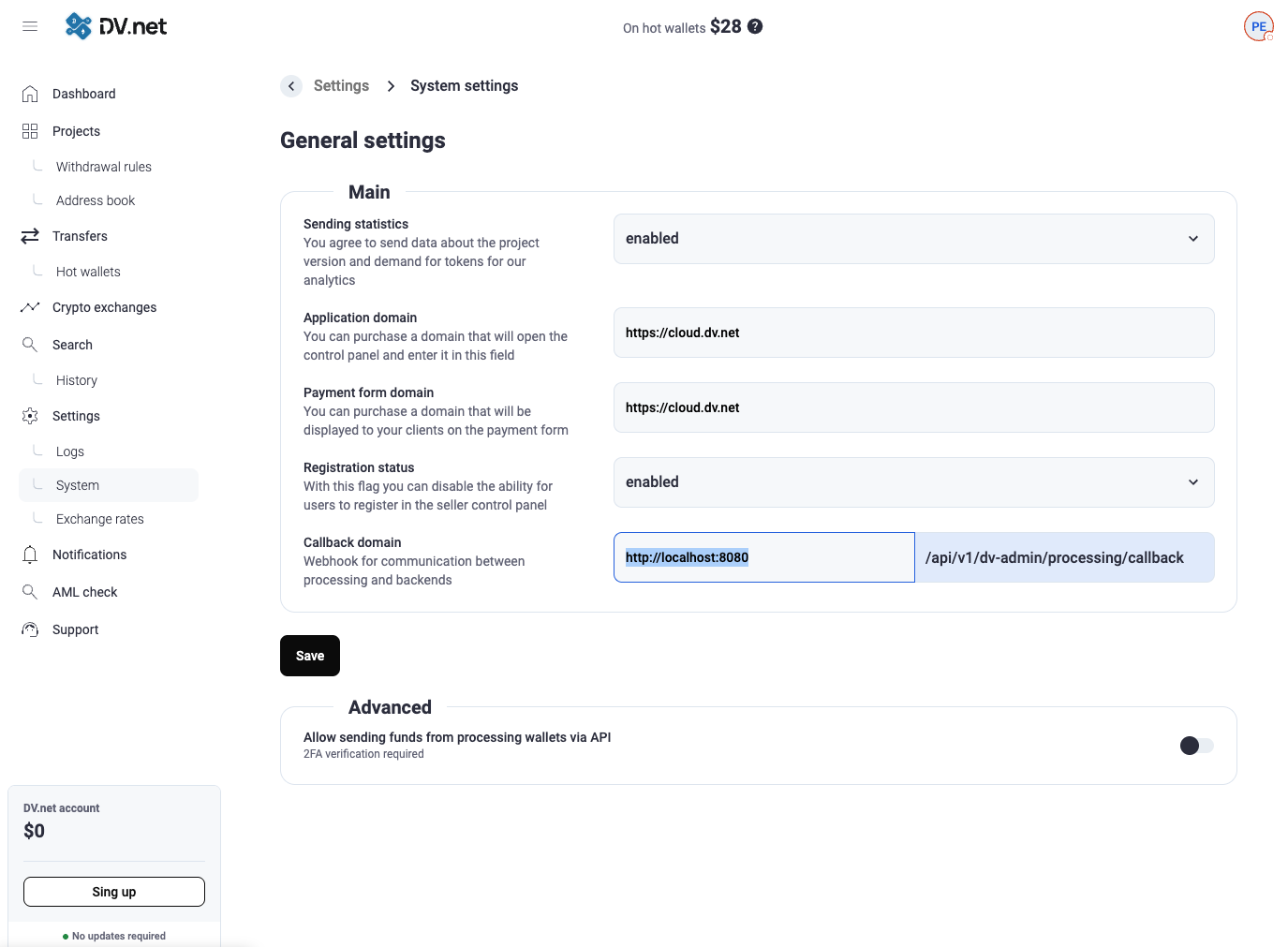Hiding the Merchant Server Administration Panel
This guide describes setting up Nginx to segment access to the Administration Panel ($/dv-admin/$), the Payment Form ($/pay/$), and the API ($/api/v1/*$) of the dv-merchant application. This enhances security by restricting access to confidential routes and providing different domains for different functions.
1. dv-merchant Route Overview
The dv-merchant server application serves both the frontend and API for several components, using the following route groups:
- /pay/: Loads the JS and frontend for the Payment Form.
- /dv-admin/: Loads the JS and frontend for the Administration Panel.
- /api/v1/public: Public API methods used by the Payment Form.
- /api/v1/external: API methods for store integration (e.g., creating an invoice).
- /api/v1/dv-admin: API methods for the Administration Panel.
2. Preliminary Setup
2.1. Nginx Installation
Install Nginx on your server. Instructions depend on your operating system (e.g., sudo apt update && sudo apt install nginx for Debian/Ubuntu).
2.2. Changing the dv-merchant Port
To operate via Nginx as a reverse proxy, switch dv-merchant to a local port (e.g., 8080) that won't be accessible externally.
Edit the configuration file: nano /home/dv/merchant/configs/config.yaml
In the 'http' section, set the new port:
http:
port: "8080"2.3. Updating the Callback Address
You must update the Callback URL from the processing system to the merchant server in the system settings so it points to the external address configured for the Payment Form (e.g., https://pay.some-domain.com).

3. Nginx Configuration
We'll create three separate Nginx configuration files (virtual hosts), each responsible for its own domain/subdomain and having its own access rules.
Important: HTTPS/SSL is recommended for all configurations (e.g., using Certbot), but the examples below use HTTP (port 80) for simplicity.
3.1. Configuration for the Payment Form (pay.some-domain.com)
This host must provide access to the Payment Form and its public API. All routes related to administration or external API must be blocked or redirected.
Create the file /etc/nginx/conf.d/pay.some-domain.com.conf:
server {
listen 80;
server_name pay.some-domain.com; # Use your domain
client_max_body_size 128M;
access_log /var/log/nginx/pay.some-domain.com.log main;
error_log /var/log/nginx/pay.some-domain.com.error.log warn;
# 1. Access to the Payment Form and Public API
location ~ ^/(pay|api/v1/public) {
proxy_pass http://localhost:8080$request_uri;
proxy_set_header Host $host;
proxy_set_header X-Forwarded-For $proxy_add_x_forwarded_for;
proxy_set_header X-Real-IP $remote_addr;
}
# 2. Block and redirect administrative and external routes
location /dv-admin {
return 403; # Access denied
}
location ~ ^/api/v1/(dv-admin|external) {
return 403; # Access denied
}
# 3. Block all other routes
location / {
return 404;
}
}3.2. Configuration for the External Store API (integration.some-domain.com)
This host should be accessible only from your store's IP addresses for API interaction (e.g., creating an invoice).
Create the file /etc/nginx/conf.d/integration.some-domain.com.conf:
server {
listen 80;
server_name integration.some-domain.com; # Use your domain
client_max_body_size 128M;
# Restrict access by IP
allow 216.58.208.196; # <-- !!! Replace with your store's IP address
# allow x.x.x.x; # Add other IPs if necessary
deny all;
access_log /var/log/nginx/integration.some-domain.com.log main;
error_log /var/log/nginx/integration.some-domain.com.error.log warn;
# 1. Access only to the external API
location /api/v1/external {
proxy_pass http://localhost:8080$request_uri;
proxy_set_header Host $host;
proxy_set_header X-Forwarded-For $proxy_add_x_forwarded_for;
proxy_set_header X-Real-IP $remote_addr;
}
# 2. Block all other routes
location / {
return 403; # Access denied to everything except /api/v1/external
}
}3.3. Configuration for the Administration Panel (panel.some-domain.com)
This host must provide access to everything related to administration and be accessible only from trusted IP addresses.
Create the file /etc/nginx/conf.d/panel.some-domain.com.conf:
server {
listen 80;
server_name panel.some-domain.com; # Use your domain
client_max_body_size 128M;
# Restrict access by IP
allow 216.58.208.196; # <-- !!! Replace with your trusted IP (office/home)
allow 216.58.208.197; # <-- !!! Replace with another trusted IP
deny all;
access_log /var/log/nginx/panel.some-domain.com.log main;
error_log /var/log/nginx/panel.some-domain.com.error.log warn;
# 1. Access to all dv-merchant routes
location / {
proxy_pass http://localhost:8080;
proxy_set_header Host $host;
proxy_set_header X-Forwarded-For $proxy_add_x_forwarded_for;
proxy_set_header X-Real-IP $remote_addr;
}
}4. Finalizing the Setup
After creating all configuration files:
- Test the Nginx configuration:bashEnsure there are no syntax errors.
sudo nginx -t - Restart Nginx:bash
sudo systemctl restart nginx - Check DNS: Make sure all three domains (
pay.some-domain.com,integration.some-domain.com,panel.some-domain.com) point to your server's IP address.
The Administration Panel (routes $/dv-admin/$ and $/api/v1/dv-admin/$) is now hidden and accessible only via the panel.some-domain.com domain from a limited set of IP addresses, while the Payment Form and External API have clearly segregated and restricted access.